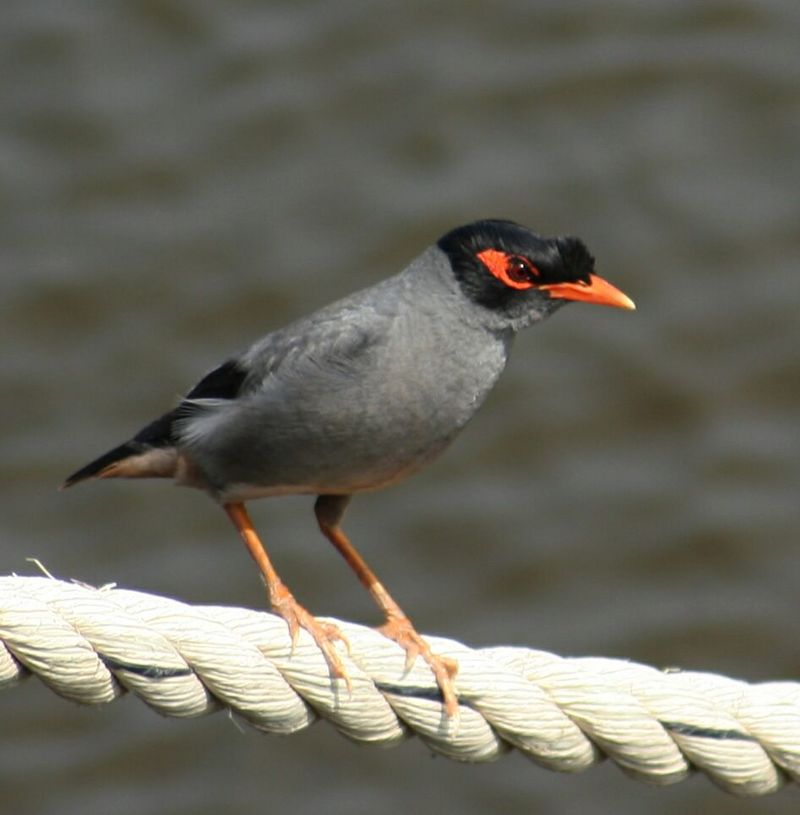| New Photos | Animal News | Animal Sounds | Animal Movies | Upload Photo | Copyright | Korean |
|---|
| Funny Animal Photos | Monsters in Animalia | Wiki Articles Fun Facts about Animals | Links | Home | Mobile A.P.A. |
|---|
| Image Info | Original File Name: 3485c_myna,bank_bithur_2007may05_09.46.54-Bank Myna (Acridotheres ginginianus).jpg Resolution: 946x964 File Size: 80488 Bytes Upload Time: 2007:10:24 10:43:33 | |
| Author | Name (E-mail): Unknown | |
| Subject | Bank Myna (Acridotheres ginginianus) - Wiki | |
 |
| Email : E-Card | Poster | Web Master Delete Edit Info Admin |
| Description | Bank Myna (Acridotheres ginginianus) - Wiki
Bank Myna
Bank Myna (Acridotheres ginginianus) is a Myna/Starling occurring in South Asia from Sind, Pakistan to Bangladesh. It is similar in colouration and shares its range with the Common Myna, but is slightly smaller. Distribution Sind, Pakistan, on the West, covering the greater part of northern India, east to Bangladesh, south to approximate latitutdes of Mumbai, Maharashtra (19N) / Balasore,Orissa (21N), except for drier regions in Rajasthan. Distribution is patchy, but most commonly in major river valleys. Mostly resident but with regular seasonal local movements in some areas. Individual stragglers documented from Kandahar, Afghanistan, and Chennai, India, the latter may have been an escaped cage bird. Local Names: Ganga myna (Hindi); Gang salik (Bengali); Barad myna (Bihar, mirshikars); Bardi myna (Nepal); Lali (Sind); Daryla myna (Uttar Pradesh). Habitat: Rocks, in open country and around human habitations, often near tea stalls, markets, etc. Railway stations are particularly favoured. Often in riverside habitats (the Hindi and Bengali names refer to this aspect). Description A stocky, bluish-grey mynah with a deep orange bill and eye patches. Noticeably smaller and greyer than the Common Mynah. Other differences include colouration: pale bluish grey instead of brown, also the black crown has a sharp boundary as opposed to a gradation, naked skin round eyes brick-red instead of yellow, wing-patch and tips of tail-feathers pinkish buff instead of white. Sexes are alike. Juveniles are paler and browner. Gregarious, often in flocks even during breeding season. Usually very tame and confiding, often seen on railway stations, sauntering confidingly along platforms, in and out of the feet and baggage of passengers, picking up bits of food. Haunts municipal refuse dumps for scraps and tidbits and attends on grazing cattle for insects. Also seen in markets (e.g. Old Delhi), surreptitiously hopping onto vendors' handcarts to steal scraps. Often following herds of cattle. Voice somewhat softer than that of Common Myna. Food Fruit, grain, and insects. Can be very destructive to ripending crops of Sorghum (jowar). An important additional insect pest, recorded among stomach contents in Bihar, is larvae of the moth Ophiusa melicerte, highly injurious to castor. Nesting Season: May to August, principally April to June. Nest: Pad of grass and rubbish, often including bits of snake slough, stuffed in the widened chamber at the end of a horizontal earth tunnels drilled in steep earth banks of rivers, sides of disused brick kilns, earthen wells, as well as other holes in masonry. Often breeds in colonies of fifty or more pairs, along with the Common Myna. Eggs: 3 to 5, glossy pale blue. http://en.wikipedia.org/wiki/Bank_Myna
| |||
| Copyright Info | AnimmalPicturesArchive.com does not have the copyright for this image. This photograph or artwork is copyright by the photographer or the original artist. If you are to use this photograph, please contact the copyright owner or the poster. |
|
|
|
| |||||||
| CopyLeft © since 1995, Animal Pictures Archive. All rights may be reserved. | ||||||||
Stats